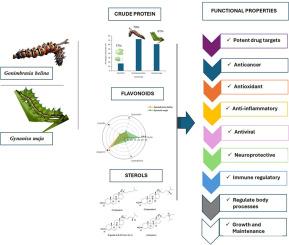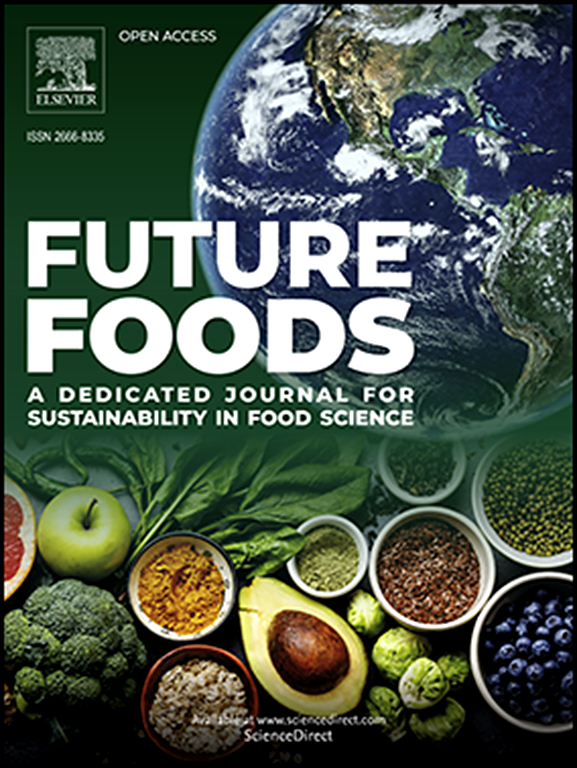Edible caterpillars (Gonimbrasia belina and Gynanisa maja) as emerging source of nutrients and bioactive compounds
IF 7.2
Q1 FOOD SCIENCE & TECHNOLOGY
引用次数: 0
Abstract
Globally, despite the commercial and cultural importance of edible caterpillars (Gynanisa maja and Gonimbrasia belina), comprehensive information on their dietary and therapeutic benefits has not been fully explored. The study was aimed at evaluating the nutritional composition and bioactive compounds profile of two important edible caterpillars (Gonimbrasia belina and Gynanisa maja) in Africa. Our results demonstrated that G. belina and G. maja are capable of amplifying host plant protein (17 %) by 4.3-folds [72.8 %] and 3.6-folds [61.3 %], respectively. Lysine (32.6 mg/g), methionine (12.5–27.1 mg/g) and valine (7.7–25.4 mg/g) value were significantly harnessed. Substantial amounts of ω−3 fatty acids (methyl 5Z,8Z,11Z,14Z,17Z-eicosapentaenoate and methyl 9Z,12Z,15Z-octadecatrienoate), minerals [iron (3.6–21.2 mg/100 g), zinc (7.1–17.3 mg/100 g), calcium (55.1–60.4 mg/100 g)] and vitamins [retinol (0.02–0.03 mg/kg), γ tocopherol (0.05–0.07 mg/kg) and α-tocopherol (1.2 mg/kg)] were detected. Important phytochemical [flavonoids: rutin (7.8–20.4 ng/g), quercetin (7.2–9.0 ng/g), luteolin (7.4–7.5 ng/g), apigenin (20.8–28.6 ng/g) and kaempferol (3.3–6.5 ng/g)] and phytosterols [stigmasta-3,5-diene, campesterol and sitosterol] were identified. These findings suggests that both edible caterpillars contain sufficient nutrients and therapeutic compounds, which when integrated into human food products, either whole, in-part, or processed will greatly contribute towards countering nutritional insecurity and improve livelihoods of people in many countries.

可食用毛虫(Gonimbrasia belina 和 Gynanisa maja)作为营养和生物活性化合物的新来源
在全球范围内,尽管食用毛虫(Gynanisa maja 和 Gonimbrasia belina)具有重要的商业和文化价值,但有关其膳食和治疗功效的全面信息尚未得到充分探索。这项研究旨在评估非洲两种重要食用毛虫(Gonimbrasia belina 和 Gynanisa maja)的营养成分和生物活性化合物概况。我们的结果表明,G. belina 和 G. maja 能够将寄主植物蛋白质(17%)分别放大 4.3 倍 [72.8 %] 和 3.6 倍 [61.3%]。赖氨酸(32.6 毫克/克)、蛋氨酸(12.5-27.1 毫克/克)和缬氨酸(7.7-25.4 毫克/克)的含量都有显著提高。1-17.3 毫克/100 克)、钙(55.1-60.4 毫克/100 克)]和维生素[视黄醇(0.02-0.03 毫克/公斤)、γ-生育酚(0.05-0.07 毫克/公斤)和α-生育酚(1.2 毫克/公斤)]。还发现了重要的植物化学物质[类黄酮:芦丁(7.8-20.4 纳克/克)、槲皮素(7.2-9.0 纳克/克)、木犀草素(7.4-7.5 纳克/克)、芹菜素(20.8-28.6 纳克/克)和山柰酚(3.3-6.5 纳克/克)]和植物甾醇[豆甾-3,5-二烯、莰酯醇和谷甾醇]。这些研究结果表明,这两种可食用毛虫都含有充足的营养成分和治疗化合物,如果将其全部、部分或加工成人类食品,将大大有助于解决营养不安全问题,改善许多国家人民的生活。
本文章由计算机程序翻译,如有差异,请以英文原文为准。
求助全文
约1分钟内获得全文
求助全文
来源期刊

Future Foods
Agricultural and Biological Sciences-Food Science
CiteScore
8.60
自引率
0.00%
发文量
97
审稿时长
15 weeks
期刊介绍:
Future Foods is a specialized journal that is dedicated to tackling the challenges posed by climate change and the need for sustainability in the realm of food production. The journal recognizes the imperative to transform current food manufacturing and consumption practices to meet the dietary needs of a burgeoning global population while simultaneously curbing environmental degradation.
The mission of Future Foods is to disseminate research that aligns with the goal of fostering the development of innovative technologies and alternative food sources to establish more sustainable food systems. The journal is committed to publishing high-quality, peer-reviewed articles that contribute to the advancement of sustainable food practices.
Abstracting and indexing:
Scopus
Directory of Open Access Journals (DOAJ)
Emerging Sources Citation Index (ESCI)
SCImago Journal Rank (SJR)
SNIP
 求助内容:
求助内容: 应助结果提醒方式:
应助结果提醒方式:


